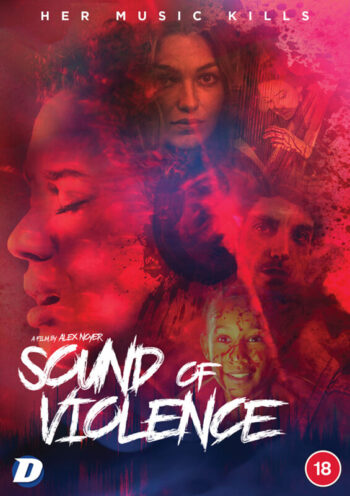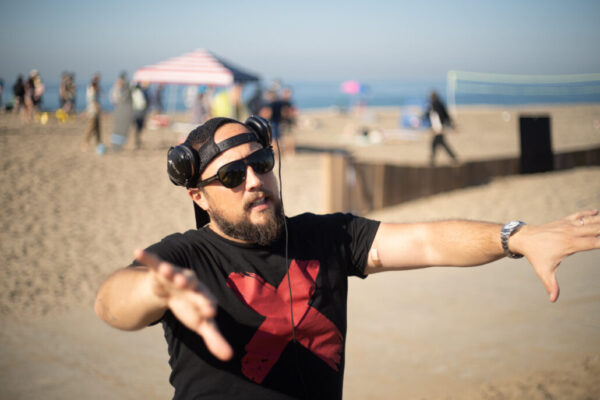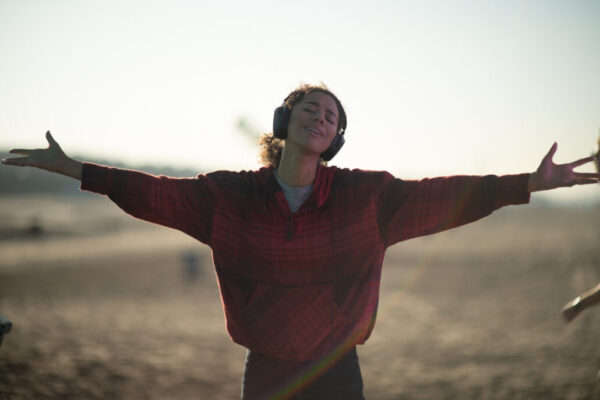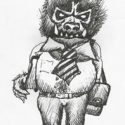
Of all the movies screening this year at FrightFest, Sound of Violence has maybe been the most talked about. Writer/ director Alex Noyer previously wowed the HorrorCultFilms teams with his short film conductor – the tale of a drum machine contest that goes very wrong (or right, depending on how you look at it). Now he’s used it as the basis for a very good feature film. HorrorCultFilms got in touch via Zoom to talk about blood, beats and collaborating to celebrate its UK Premiere. Note that the transcript has been edited in places, and something that may not come across in the written form is that Noyer is just about the most enthusiastic filmmakers I’ve spoken to. And I interviewed Jennifer Tilly…
This movie was inspired by the short film conductor you made back in 2018. How did that come about for you?
It was a very transitional piece in my career because I’ve been a producer for 17 years, but for the bulk of it, I was, I was producing documentaries. And my documentary career kind of culminated with a movie called 808 about the legendary drum machine, and that took over five years of my life. We worked with the Beastie Boys, Phil Collins – name it. It was amazing. And at the same time, I was a bit exhausted and needed to change – I needed to focus on something different. So then, my wife suggested I should get into horror movies because of my lifelong passion. I was developing a few projects, but then I was reminiscing about 808 because I couldn’t get it out of my head, and this is when the light bulb appeared: I need to kill somebody with a drum machine.
It was a terrific short that deservedly went viral. As with this one, it gets nasty towards the end, and as a filmmaker, do you take glee in making a memorable, gory kill.
As a filmmaker, it’s essential not to be forgettable. Being forgettable is the death of filmmaking. Either people love it or hate it, but at least you want them to be remembering it. But as far as the gore in this, I love practical effects and having fun with them. But obviously, there’s a distinct level of gore between the short and the feature – because what happens in the short, I could not have sustained for 90 minutes – and in the film, it’s funny because I always have the feeling that people seem to think they saw more than they did. Because there’s so much less than, for example, in the short – where we’re really in there with a camera in cuts in the guts of it. I just love the idea of you making the most out of practical effects. To create something almost like a sculpture – people really appreciate them when they’re good. I mean that was the first award we picked up for the short: for our special effects, and it’s something I’ll always cherish. And there’s a lot of practical effects in the feature. There’s some stuff that we had to do digitally because of the impossibility of making them practically. But I would say 80 to 85% of it would be practical and I’m a stickler about blood dope. And I’m very, very lucky to work with somebody I’ve nicknamed my blood wizard, Robert Bravo, who understands my psychosis about the way blood needs to look, needs to drip, needs to shine, needs to everything. And I’m pretty proud to say that the blood looks fantastic and my films.
And when it came to taking this short film and turning it into a feature, what were the main considerations for you?
First and foremost was realising that what I did in the short could not transfer directly into a film. Across festivals, I got the most questions about Alexis – she is very elusive in the short, but I wanted to give her purpose. And I decided that was where I needed to build on – the character of Alexis was the basis of making a feature, not the method of killing. But the fact that it’s a story of an artist. I first wrote an intense and gory script, but the character study became perhaps a little weak. I went to Cannes had started raising finance, and the feedback was always ‘get us this character as the core of your story – make it a character thriller’. And I was very excited about that because I didn’t need permission, but I definitely needed the encouragement, and I came back, and I rewrote the script and four days as a character thriller. It was a page-one rewrite and I had so much fun. And that’s where it hit me that I had a real human journey as well, amid all this carnage – and the main purpose was to create a challenge to the audience. It’s not, as I’ve read online, that I’m telling them to sympathise with the killer. I’m just asking them to undo the handbrake and sit back and just go through the journey and figure out how they feel because it will be conflictual. Because she is an extremely likeable person, but what she does is impossible to like so. That inner conflict is part of the fun of this film, and not asking them to like her or just sympathise with her – I’m asking them not to rule it out.
You don’t hide away from how wrong it is. Without going into spoiler territory, I’m going to be thinking about one particular scene for a long time: the finale. Without spoilers, was that something you planned from the start or that came to you while you wrote it?
It’s great that you’re asking that because I love telling that story. A lot of people will look through the movie and try to kind of match the movie references throughout and find okay, this is inspired by this, and this is, you know its misery American psycho blah blah blah blah blah. And then comes the finale. And the finale came to me in a dream. I had an ending that I was writing, and I hated it – I hated it, I hated it, I hated it, I hated it! Then in the middle of the night, I saw this, and I woke up. So, I sketched. As my producing partner will tell you, I sketch like a demented child. And so I do my drawing, and I sent it to him, and I sent it to Robert Bravo, and they both laughed, cried and gasped the at the idea. And there you go. I’m very, very, very, very, very proud of it, I heard the comparisons to certain movies, and I love that it makes some people think about them. But with this one, I had no movie in mind – it came to me at night.
Oh wow – in the dream, was the final happening to you or someone else?
It was faceless: it was much more abstract. But I just saw the detail of it. I didn’t see the broad picture, but I saw the details and the idea. Of course, like every dream, you don’t remember everything, but it was just like I had this idea, and I sketched it immediately.
Regarding Alexis, what were you looking for in a performer? And did you develop the character with Jasmin Savoy Brown?
First of all, I need to give credit to our casting director because she got a grasp of the script, and she suggested Jasmin, and I knew her from The Leftovers. So, I saw her suggestion and was like, ‘oh yeah, it’s such a great idea’. Then I met Jasmin, and I felt I had met Alexis. This character cannot live or exist without somebody willing to meet me halfway. And I’m not talking only about her identity, which obviously was essential to get right and authentically – it’s very important that if I’m going to take on the journey of writing a character like that, I had an actress that shared those traits. The life of a queer, black woman today cannot be told unless it’s authentically told. But as far as the killer and the story and the environment that she represents, Jasmin had a unique grasp of it. She is an artist, she’s very passionate and intense about her process, and I love that because I knew that she would push me and never allow me to get it wrong. I was very, very happy to collaborate with her to get it right. It was important that none of this tapped into cliches – especially when it comes to her art. Jasmin is a musician, so again that allowed that relationship with the rhythm. On the set, we were really immersed in it. Collaborating with Jasmin was rewarding beyond belief because we would speak, bounce ideas, and talk in the evening every day. English is not my first language, so as well as adjusting the dialogue, so it felt a little more natural, I needed somebody willing to really collaborate with me to bring it to that level. And I’m just so proud that she accepted to take on that role, and she brought so much, and her performance is dizzying. It’s head-turning – she is fantastic, and I will always be grateful to her, and I hope to work with her again. Now she’s doing the new Scream and she has this new TV show, The Yellowjackets. I mean, if I did this movie today, I probably would not be able to get her so I’m a very, very lucky guy. And Jasmin, if you’re reading this, thank you again for that.
With that point about her doing Scream now, I believe you were filming this late 2019. How has it been waiting to get it out since then?
We had plans for a Summer 2020 release, but with Covid, we had to stretch out our postproduction. We had collaborators getting it, and people quarantined at home working remotely on many, many parts of it. We’re very lucky to have been able to shoot the film before the world shut down – we ended the film in November, but then we had some pickup dates, for example, in February 2021, just before it happened. And yeah, after that, we had to get to weather the storms. But it also allowed us to create new opportunities. For example, the mixing stage – that we call the dub stage and the deal with them. I mean, no way did we have the budget to work with such a huge, amazing mixing stage but they said, ‘well if you can work with our schedule, we’ll tell you when we’re available, and we’ll make it will make a good deal’. Then, in December, I got an email on the 23rd of December I got an email to tell me that we got into SXSW. I had 808 at South by Southwest, but SXSW is so much to me – I was bouncing up and down. And now FrightFest!

I think this is going to look and sound great on the big screen. I was impressed with how you represented synaesthesia on screen. How did that look come about?
So, in the script, I use every word I could to describe the northern lights – my Finnish side. The Northern lights were the inspiration for what she was seeing – a spectrum of light and allowing all this in 3D space. And then, we developed this – I want that colour, I wanted a psychedelic feeling to give a manifestation to the creative high. And that is not easy to do when it’s sound-based. It needed to allow us to show the audience that she is immersed in that. When it comes to the murder, she’s never in that world. It’s all the sounds. So, we worked with my cinematographer to create the lights practically as well. We had those tubes that we could program colours for – and in some of the scenes, I’m literally in front of Jasmin dancing like in an old-time disco with my two glowsticks. Then we had lights in the back as well; we were moving around, and then with the VFX, we could create this visual explosion. I’m very, very proud to say that synaesthesia has not been used in horror – that blew my mind. I was like, ‘how is that possible?’ I am ecstatic that has never been done before, but how is that possible? I’m just happy that we can really mess with human sensation visually and create something that gives the audience a visual marker. Especially in a movie where we’re following the killer. You see what she hears.
What sort of sounds do you respond to the most?
It’s the sound of beats, which makes sense – I mean, I made a documentary about a drum machine, I already killed somebody with a drum machine, and then I’m making a movie about the soundscape of death. But yeah, for me, beats. I have a very broad taste in music. I was a DJ – was not a very good DJ – but I kept being asked to play because of the diversity of the music I was playing. And I was trying to keep a sort of rhythmic storytelling going – so yeah, beats always got me and then certain voices would give me shivers down my spine and then certain songs would get me going, more than anything. You know Smashing Pumpkins track Bullet with Butterfly Wings? I was asked what’s what song is your cathartic song, and I just said that. And they’re looking at me: ‘you mean the world is a vampire?’ Yeah, you have all that, and then it explodes. I love that song, and… I don’t know if I answered your question at all because I went on the riff.
I enjoyed the music – far more than Alexis’ classmates did. I thought it was cool. Were you trying to make something you liked, or just something fucked up?
I’m just secretly hoping that Trent Reznor sees my movie – that’s all. So, Trent, if you’re reading, please watch my movie. And the classroom track could be a Nine Inch Nails track – you can hear him singing on that.
Absolutely – it had me thinking of Pretty Hate Machine.
I killed somebody with a drum machine – now a theremin. It’s so spooky you – it’s mostly in Star Trek soundtracks, but it’s the spookiest of all instruments. And so I tried to delve into instruments that I could really get into, and also I didn’t want to do like because I know people compare my movie to Saw. I don’t think it is like soul, but you know, whatever. But in Saw, the traps are huge -industrial-sized contraptions – here, the musical instruments control things. I’m not going to say they’re feasible and that everybody could build them – but they’re not out of the realm of possibility.

I wonder if the comparison comes from the police procedural bits. Because Sound of Violence is very different – we’re not focussing on the people in the traps. So, it isn’t anything like Saw meets Whiplash or anything.
You know how many people just commented, ‘Saw the musical?’ It’s not. I love Saw, by the way – I love the franchise, and there was something so innovative about it. I just feel that I was trying to pet to create my own path where it’s almost not about the victims. Some of them make it quite easy to dislike them. She humanises them because it’s about the music – she’s never watching them die. She’s never turned towards them. Everything that she feels happens when it hits her musically. So I just wanted to create them as collateral damage in the midst of a creative process. And you’re right – they’re not there to survive.
I assume that this was going to R when it comes out in the states?
I think it came out unrated – but if it were, it would be a very hard R. A pirate Arrrrr.
More violent films were big about a decade ago now. But I think Sound of Violence fits right into did today’s landscape; there’s such a personal journey to it.
The first version I wrote was a lot gorier, but it was weak on the storyline and character. Believe it or not, I decided to reduce the gore. Again, people feel they see a lot more than they actually see. The gore is nowhere near the level of some of the goriest movies in recent memory – it’s just because of the brutality. Sometimes the brutality feels more visceral than the actual gore. But when I decided to turn it into a character thriller, the first thing I did was cut 24 pages of gore. And that’s because, like in the short, I was describing how the blood drops are going. Again, it’s the crazy blood stickler than I am. But yeah, I toned that down and moved away from what the short did to focus on the character. I firmly believe that this film is not as gory as people think.
That happens. You come away from things like Jaws remembering way more violence than there is.
We remember a fountain of blood in the middle of the sea, but when we look at it today, it’s like ‘oh, there actually was not much blood’ – it’s a PG. We’d never get a PG.
Or even something like The Texas Chainsaw Massacre, where there’s almost no blood.
It’s so unnerving that you’re projecting. And this is what I’m trying to make the audience do. I want them to have a conflicting relationship with this film, with the character and everything that’s happening. And if at some point they decide to close their eyes from what they’re seeing, I’ll get them with the sound.
And last question – what are you up to next?
I’m working on a few things – nothing I can say too much about. One project is a project I’m writing, which is tapping into my Nordic origins, so I’m quite excited about that. And another one is actually a PG 13 movie. There are a few other things I’m in talks with but let’s see when they get announced. The Nordic one is something I’m writing, and the other one, the PG 13, is something I’m not writing. But I’m also very excited to potentially sink my teeth into something that I didn’t write. Again, I love the collaboration part – so I’m excited. Some people also have asked me if I would turn to drama or comedy, and nothing’s off the table.
Sound of Violence has its UK Premiere at FrightFest, Sunday 29th August.





Be the first to comment